Temporal-Spatial Thermal Comfort Across Urban Blocks with Distinct Morphologies in a Hot Summer and Cold Winter Climate: On-Site Investigations in Beijing
Abstract
1. Introduction
- (1)
- systematically examine the OTC distributions in different urban blocks with distinct built environments;
- (2)
- thoroughly reveal the relationships between OTC and urban morphological features in different urban blocks over time; and
- (3)
- critically explore the applicability and effectiveness of physical parameters that could better define urban morphology in evaluating OTC variations.
2. Methodology
2.1. Climatic Condition of the Study Area
2.2. Selection of Urban Blocks
2.3. Thermal Walk
2.3.1. Experiment Design and Schedule
2.3.2. Questionnaire Survey
2.3.3. Meteorological Parameters Measurement
2.4. Calculation of Morphological Indicators
2.5. Applicability of Black Globe Temperature
3. Results and Analysis
3.1. OTC Variation Across Different Blocks
3.1.1. All-Day Average OTC Comparison
3.1.2. OTC Comparison Across Different Time Periods
- Summer
- b.
- Winter
3.1.3. OTC Variation Among Different Measuring Points in Three Blocks
3.2. Impact of Built Environment Variables on OTC
3.2.1. Morphological Factors
3.2.2. Effect of Street Orientation on OTC
4. Discussion
4.1. Impact of Block Morphology on OTC
4.2. Applicability of Spatial Morphological Factors in Evaluating OTC Across Different Blocks
4.2.1. Applicability of SVF, BCR, and BH
4.2.2. Applicability of Street Orientation
4.3. Emphasis of OTC Optimization in Different Blocks
4.4. Limitations
5. Conclusions and Future Implications
- (1)
- Thermal sensation votes and globe temperature measurements indicated significant discrepancies in OTC distributions across different urban blocks. During summer, the OTC conditions were ranked as BD > RA > HN. In contrast, during the winter, the OTC conditions were HN = RA > BD. Consequently, BD in Beijing need to prioritize the optimization of OTC during winter, whereas historical districts require a primary focus on enhancing OTC during summer. The OTC discrepancy was attributed to differences in the spatial morphology of each block.
- (2)
- SVF, BCR, and BH were identified as key morphological indicators affecting the OTC of Beijing’s urban blocks, with the impact of SVF being the most pronounced. However, the influential indicators varied across different blocks. None of the spatial morphology factors significantly affected the OTC in BD because the irregular distribution of tall buildings resulted in random OTC conditions at different locations.
- (3)
- Street orientation has been proven to be a crucial factor affecting OTC. In Beijing, N–S-oriented streets were cooler in the summer and warmer in the winter compared to E–W-oriented streets, resulting in better OTC conditions for N–S-oriented streets throughout the year.
- (4)
- The influence of spatial morphology on OTC varied greatly across seasons and times of day. The impact was more substantial in summer than in winter and more substantial during midday than in the morning or late afternoon. Consequently, more targeted OTC studies must be conducted from climatic, temporal, and spatial aspects.
- (5)
- SVF, BCR, BH, and orientation demonstrate great applicability in assessing OTC. However, the effectiveness varied with weather conditions, times of day, and blocked spatial morphologies. Generally, SVF is the most effective parameter. In addition, more applicable design parameters, such as BCR, BH, and orientation, could be involved as effective supplements of dimensionless parameters in evaluating OTC in complex urban contexts.
Author Contributions
Funding
Institutional Review Board Statement
Informed Consent Statement
Data Availability Statement
Conflicts of Interest
Nomenclature
| BCR | Building Coverage Ratio (%) | mTg | Mean Tg (°C) |
| BD | Building District | Va | Wind Speed (m/s) |
| BH | Building Height (m) | RA | Residential Area |
| Dwa | Hot Humid Continental Climate | RH | Relative Humidity |
| E–W | East–West | SVF | Sky View Factor |
| HN | Historical Neighborhood | TCV | Thermal Comfort Vote |
| mTCV | Mean TCV | TSV | Thermal Sensation Vote |
| mTSV | Mean TSV | Ta | Air Temperature (°C) |
| N–S | North–South | Tg | Black Globe Temperature (°C) |
| OTC | Outdoor Thermal Comfort |
Appendix A. The Fisheye Photos of Each Measuring Point During Summer
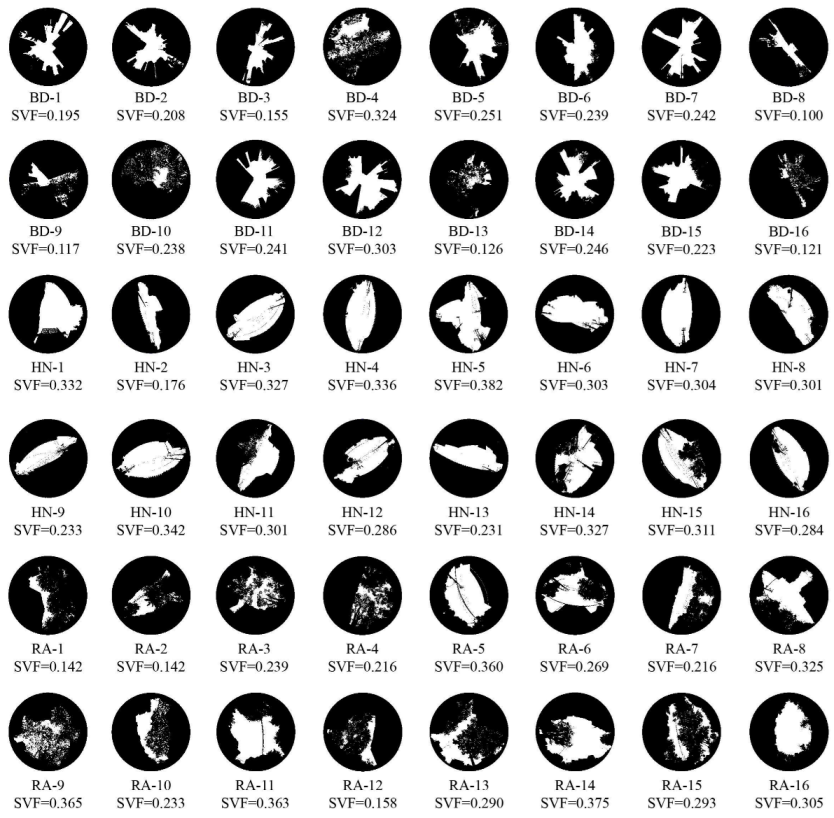 |
Appendix B. The Fisheye Photos of Each Measuring Point During Winter
 |
Appendix C. The BCR and BH Value of Each Measuring Point and Each Block
| Business District (BD) | Historical Neighborhood (HN) | Residential Area (RA) | ||||||
| Point No. | BCR | BH (m) | Point No. | BCR | BH (m) | Point No. | BCR | BH (m) |
| 1 | 23.7% | 95.9 | 1 | 68.6% | 3.6 | 1 | 22.5% | 24.9 |
| 2 | 23.5% | 36.9 | 2 | 63.4% | 3.5 | 2 | 29.9% | 22.6 |
| 3 | 48.2% | 57.8 | 3 | 63.7% | 3.7 | 3 | 21.1% | 16.1 |
| 4 | 24.7% | 68.0 | 4 | 69.5% | 4 | 4 | 21.3% | 15.1 |
| 5 | 16.7% | 107.2 | 5 | 66.8% | 3.5 | 5 | 15.9% | 8.5 |
| 6 | 30.2% | 39.6 | 6 | 62.2% | 3.6 | 6 | 27.3% | 13.4 |
| 7 | 14.2% | 122.4 | 7 | 68.0% | 3.6 | 7 | 14.5% | 17.9 |
| 8 | 52.2% | 42.0 | 8 | 67.8% | 4.2 | 8 | 29.1% | 12.0 |
| 9 | 29.4% | 137.9 | 9 | 64.7% | 3.9 | 9 | 31.5% | 18.0 |
| 10 | 19.2% | 232.9 | 10 | 67.8% | 3.9 | 10 | 26.8% | 18.0 |
| 11 | 12.6% | 212.2 | 11 | 58.4% | 3.4 | 11 | 25.3% | 18.0 |
| 12 | 2.3% | 3.0 | 12 | 67.0% | 3.6 | 12 | 33.5% | 17.8 |
| 13 | 21.9% | 29.8 | 13 | 67.0% | 4.2 | 13 | 15.2% | 21.0 |
| 14 | 26.7% | 17.3 | 14 | 67.2% | 3.7 | 14 | 15.4% | 18.0 |
| 15 | 15.7% | 20.2 | 15 | 65.5% | 3.9 | 15 | 22.2% | 14.4 |
| 16 | 19.4% | 62.9 | 16 | 66.9% | 3.8 | 16 | 26.5% | 17.1 |
| Mean | 23.8% | 80.4 | Mean | 65.9% | 3.8 | Mean | 23.6% | 17.0 |
References
- Fong, C.S.; Aghamohammadi, N.; Ramakreshnan, L.; Sulaiman, N.M.; Mohammadi, P. Holistic recommendations for future outdoor thermal comfort assessment in tropical Southeast Asia: A critical appraisal. Sustain. Cities Soc. 2019, 46, 101428. [Google Scholar] [CrossRef]
- Hedquist, B.; Brazel, A.J. Seasonal variability of temperatures and outdoor human comfort in Phoenix, Arizona, USA. Build. Environ. 2014, 72, 377–388. [Google Scholar] [CrossRef]
- Wang, Y.P.; Berardi, U.; Akbari, H. Comparing the effects of urban heat island mitigation strategies for Toronto, Canada. Energy Build. 2016, 114, 2–19. [Google Scholar] [CrossRef]
- Smith, P.; Henríquez, C. Perception of thermal comfort in outdoor public spaces in the medium-sized city of Chillán, Chile, during a warm summer. Urban Clim. 2019, 30, 100525. [Google Scholar] [CrossRef]
- Vieira, J.T.S.; Silveira, Q.S.H. Predicting urban thermal comfort from calibrated UTCI assessment scale—A case study in Belo Horizonte city, southeastern Brazil. Urban Clim. 2021, 36, 100652. [Google Scholar] [CrossRef]
- Mazzeo, D.; Kontoleon, J.K. The role of inclination and orientation of different building roof typologies on indoor and outdoor environment thermal comfort in Italy and Greece. Sustain. Cities Soc. 2020, 60, 102111. [Google Scholar] [CrossRef]
- Diz-Mellado, E.; Nikolopoulou, M.; López-Cabeza, V.P.; Rivera-Gómez, C.; Galán-Marín, C. Cross-evaluation of thermal comfort in semi-outdoor spaces according to geometry in Southern Spain. Urban Clim. 2023, 49, 101491. [Google Scholar] [CrossRef]
- Baruti, M.M.; Johansson, E.; Yahia, W.M. Urbanites’ outdoor thermal comfort in the informal urban fabric of warm-humid Dar es Salaam, Tanzania. Sustain. Cities Soc. 2020, 62, 102380. [Google Scholar] [CrossRef]
- Hassan, S.A.A.; Ahmed, M.R.M. Urban morphology as an adaptation strategy to improve outdoor thermal comfort in urban residential community of new Assiut city, Egypt. Sustain. Cities Soc. 2022, 78, 103648. [Google Scholar] [CrossRef]
- Li, J.; Liu, N. The perception, optimization strategies and prospects of outdoor thermal comfort in China: A review. Build. Environ. 2020, 170, 106614. [Google Scholar] [CrossRef]
- Kim, Y.; Yu, S.; Li, D.; Gatson, S.N.; Brown, R.D. Linking landscape spatial heterogeneity to urban heat island and outdoor human thermal comfort in Tokyo: Application of the outdoor thermal comfort index. Sustain. Cities Soc. 2022, 87, 104262. [Google Scholar] [CrossRef]
- Shooshtarian, S.; Lam, C.K.C.; Kenawy, I. Outdoor thermal comfort assessment: A review on thermal comfort research in Australia. Build. Environ. 2020, 177, 106917. [Google Scholar] [CrossRef]
- Tan, Z.; Lau, K.K.-L.; Ng, E. Urban tree design approaches for mitigating daytime urban heat island effects in a high-density urban environment. Energy Build. 2016, 114, 265–274. [Google Scholar] [CrossRef]
- Middel, A.; Häb, K.; Brazel, A.J.; Martin, C.A.; Guhathakurta, S. Impact of urban form and design on mid-afternoon microclimate in Phoenix Local Climate Zones. Landsc. Urban Plan. 2014, 122, 16–28. [Google Scholar] [CrossRef]
- Peng, C.; Ming, T.; Tao, Y.; Peng, Z. Numerical analysis on the thermal environment of an old city district during urban renewal. Energy Build. 2015, 89, 18–31. [Google Scholar] [CrossRef]
- Salata, F.; Golasi, I.; Petitti, D.; de Lieto Vollaro, E.; Coppi, M.; de Lieto Vollaro, A. Relating microclimate, human thermal comfort and health during heat waves: An analysis of heat island mitigation strategies through a case study in an urban outdoor environment. Sustain. Cities Soc. 2017, 30, 79–96. [Google Scholar] [CrossRef]
- Galal, O.M.; Sailor, D.J.; Mahmoud, H. The impact of urban form on outdoor thermal comfort in hot arid environments during daylight hours, case study: New Aswan. Build. Environ. 2020, 184, 107222. [Google Scholar] [CrossRef]
- Callejas, I.J.A.; Krüger, E. Microclimate and thermal perception in courtyards located in a tropical savannah climate. Int. J. Biometeorol. 2022, 66, 1877–1890. [Google Scholar] [CrossRef]
- Nikolopoulou, M.; Steemers, K. Thermal comfort and psychological adaptation as a guide for designing urban spaces. Energy Build. 2003, 35, 95–101. [Google Scholar] [CrossRef]
- Kumar, P.; Sharma, A. Assessing the outdoor thermal comfort conditions of exercising people in the semi-arid region of India. Sustain. Cities Soc. 2022, 76, 103366. [Google Scholar] [CrossRef]
- Dzyuban, Y.; Ching, G.N.Y.; Yik, S.K. Outdoor thermal comfort research in transient conditions: A narrative literature review. Landsc. Urban Plan. 2022, 226, 104496. [Google Scholar] [CrossRef]
- Peng, Z.; Bardhan, R.; Ellard, C.; Steemers, K. Urban climate walk: A stop-and-go assessment of the dynamic thermal sensation and perception in two waterfront districts in Rome, Italy. Build. Environ. 2022, 221, 109267. [Google Scholar] [CrossRef]
- Deng, X.; Nie, W.; Li, X.; Wu, J.; Yin, Z.; Han, J.; Pan, H.; Lam, C.K.C. Influence of built environment on outdoor thermal comfort: A comparative study of new and old urban blocks in Guangzhou. Build. Environ. 2023, 234, 110133. [Google Scholar] [CrossRef]
- Tian, Y.; Hong, B.; Zhang, Z.; Wu, S.; Yuan, T. Factors influencing resident and tourist outdoor thermal comfort: A comparative study in China’s cold region. Sci. Total Environ. 2022, 808, 152079. [Google Scholar] [CrossRef]
- Zhu, R.; Zhang, X.; Yang, L.; Liu, Y.; Cong, Y.; Gao, W. Correlation analysis of thermal comfort and physiological responses under different microclimates of urban park. Case Stud. Therm. Eng. 2022, 34, 102044. [Google Scholar] [CrossRef]
- Vasilikou, C.; Nikolopoulou, M. Outdoor thermal comfort for pedestrians in movement: Thermal walks in complex urban morphology. Int. J. Biometeorol. 2020, 64, 277–291. [Google Scholar] [CrossRef]
- Yang, Z.; Peng, J.; Jiang, S.; Yu, X.; Hu, T. Optimizing building spatial morphology to alleviate human thermal stress. Sustain. Cities Soc. 2024, 106, 105386. [Google Scholar] [CrossRef]
- Ariane, M.; Jonas, L.; Ross, M.; Matthias, D.; Matthias, R. Sky View Factor footprints for urban climate modeling. Urban Clim. 2018, 25, 120–134. [Google Scholar] [CrossRef]
- Chen, L.; Ng, E.; An, X.; Ren, C.; Lee, M.; Wang, U.; He, Z. Sky view factor analysis of street canyons and its implications for daytime intra-urban air temperature differ-entials in high-rise, high-density urban areas of Hong Kong: A GIS-based simulation approach. Int. J. Climatol. 2012, 32, 121–136. [Google Scholar] [CrossRef]
- Acero, J.A.; Koh, E.J.Y.; Ruefenacht, L.A.; Norford, L.K. Modelling the influence of high-rise urban geometry on outdoor thermal comfort in Singapore. Urban Clim. 2021, 36, 100775. [Google Scholar] [CrossRef]
- Ali-Toudert, F.; Mayer, H. Numerical study on the effects of aspect ratio and orientation of an urban street canyon on outdoor thermal comfort in hot and dry climate. Build. Environ. 2006, 41, 94–108. [Google Scholar] [CrossRef]
- Johansson, E. Influence of urban geometry on outdoor thermal comfort in a hot dry climate: A study in Fez, Morocco. Build. Environ. 2006, 41, 1326–1338. [Google Scholar] [CrossRef]
- Bhaskar, D.; Mukherjee, M. Optimizing street canyon orientation for Rajarhat Newtown, Kolkata, India. Environ. Clim. Technol. 2017, 21, 5–17. [Google Scholar] [CrossRef]
- Zhang, J.; Cui, P.; Song, H. Impact of urban morphology on outdoor air temperature and microclimate optimization strategy base on Pareto optimality in Northeast China. Build. Environ. 2020, 180, 107035. [Google Scholar] [CrossRef]
- Narimani, N.; Karimi, A.; Brown, R.D. Effects of street orientation and tree species thermal comfort within urban canyons in a hot, dry climate. Ecol. Inform. 2022, 69, 101671. [Google Scholar] [CrossRef]
- Honjo, T.; Lin, T.-P.; Seo, Y. Sky view factor measurement by using a spherical camera. J. Agric. Meteorol. 2019, 75, 59–66. [Google Scholar] [CrossRef]
- Kántor, N.; Unger, J. The most problematic variable in the course of human-biometeorological comfort assessment—The mean radiant temperature. Cent. Eur. J. Geosci. 2011, 3, 90–100. [Google Scholar] [CrossRef]
- Zhao, H.; Xu, G.; Shi, Y.; Zhai, Y.; Zhao, L.; Brown, R.D. Evaluation of pedestrian thermal comfort from a whole-trip perspective: An outdoor empirical study. Sustain. Cities Soc. 2024, 115, 105872. [Google Scholar] [CrossRef]
- Ma, T.; Zhang, J. Integrating thermal perception and public space use—An experimental outdoor comfort study in cold winter-hot summer zone: Beijing, China. Urban Clim. 2024, 58, 102138. [Google Scholar] [CrossRef]
- Lai, D.; Liu, W.; Gan, T.; Liu, K.; Chen, Q. A review of mitigating strategies to improve the thermal environment and thermal comfort in urban outdoor spaces. Sci. Total Environ. 2019, 661, 337–353. [Google Scholar] [CrossRef]
- Mohite, S.; Surawar, M. Impact of urban street geometry on outdoor pedestrian thermal comfort during heatwave in Nagpur city. Sustain. Cities Soc. 2024, 108, 105450. [Google Scholar] [CrossRef]
- Darbani, E.S.; Rafieian, M.; Parapari, D.M.; Guldmann, J.-M. Urban design strategies for summer and winter outdoor thermal comfort in arid regions: The case of historical, contemporary, and modern urban areas in Mashhad, Iran. Sustain. Cities Soc. 2023, 89, 104339. [Google Scholar] [CrossRef]
- Guo, L.; Guo, X.; Li, B.; Wang, E. The impact of block morphology on urban microclimates: A case study of three cities in cold regions of China. Urban Clim. 2024, 57, 102098. [Google Scholar] [CrossRef]
- Jamei, E.; Rajagopalan, P.; Seyedmahmoudian, M.; Jamei, Y. Review on the impact of urban geometry and pedestrian level greening on outdoor thermal comfort. Renew. Sustain. Energy Rev. 2016, 54, 1002–1017. [Google Scholar] [CrossRef]
- Cui, P.; Lu, J.; Wu, Y.; Tang, J.; Jiang, J. Effect of urban morphology on microclimate and building cluster energy consumption in cold regions of China. Sustain. Cities Soc. 2024, 115, 105838. [Google Scholar] [CrossRef]
- Bourbia, F.; Awbi, H.B. Building cluster and shading in urban canyon for hot dry climate: Part 2: Shading simulations. Renew. Energy 2004, 29, 291–301. [Google Scholar] [CrossRef]
- Labdaoui, K.; Mazouz, S.; Acidi, A.; Cools, M.; Moeinaddini, M.; Teller, J. Utilizing thermal comfort and walking facilities to propose a comfort walkability index (CWI) at the neighbourhood level. Build. Environ. 2021, 193, 107627. [Google Scholar] [CrossRef]
- Abdollahzadeh, N.; Biloria, N. Outdoor thermal comfort: Analyzing the impact of urban configurations on the thermal performance of street canyons in the humid subtropical climate of Sydney. Front. Archit. Res. 2021, 10, 394–409. [Google Scholar] [CrossRef]
- Kim, S.W.; Brown, R.D. Pedestrians’ behavior based on outdoor thermal comfort and micro-scale thermal environments, Austin, TX. Sci. Total Environ. 2022, 808, 152143. [Google Scholar] [CrossRef]
- Canan, F.; Golasi, I.; Falasca, S.; Salata, F. Outdoor thermal perception and comfort conditions in the Köppen-Geiger climate category BSk. One-year field survey and measurement campaign in Konya, Turkey. Sci. Total Environ. 2020, 738, 140295. [Google Scholar] [CrossRef]
- Cooper, E.; Grundstein, A.; Rosen, A.; Miles, J.; Ko, J.; Curry, P. An Evaluation of Portable Wet Bulb Globe Temperature Monitor Accuracy. J. Athl. Train. 2017, 52, 1161–1167. [Google Scholar] [CrossRef]
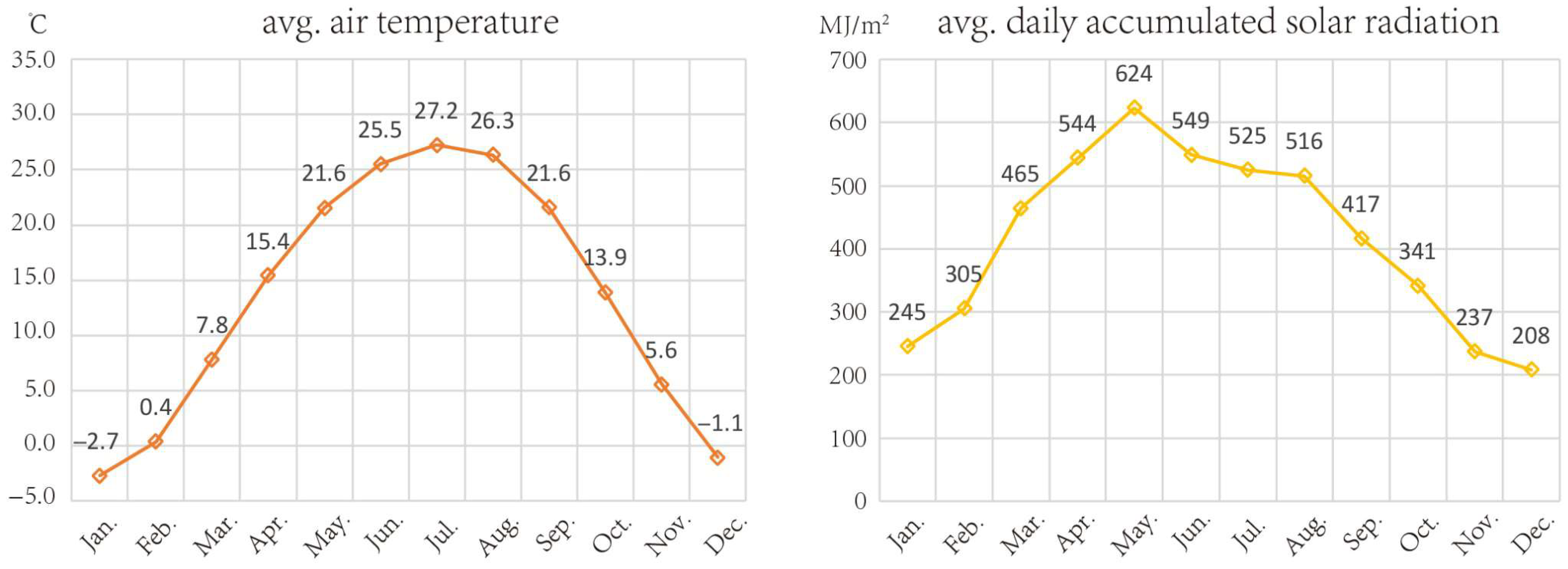
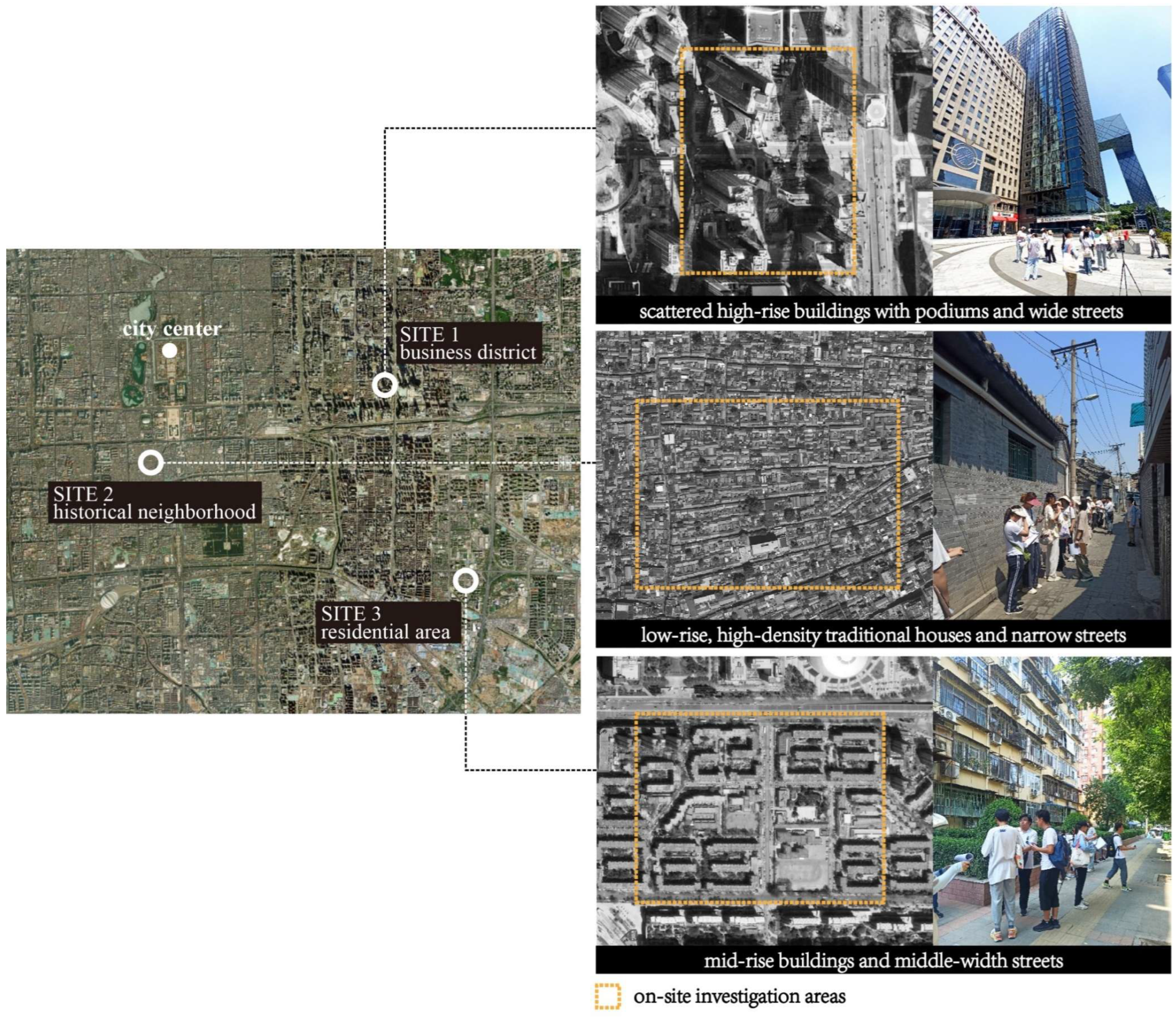
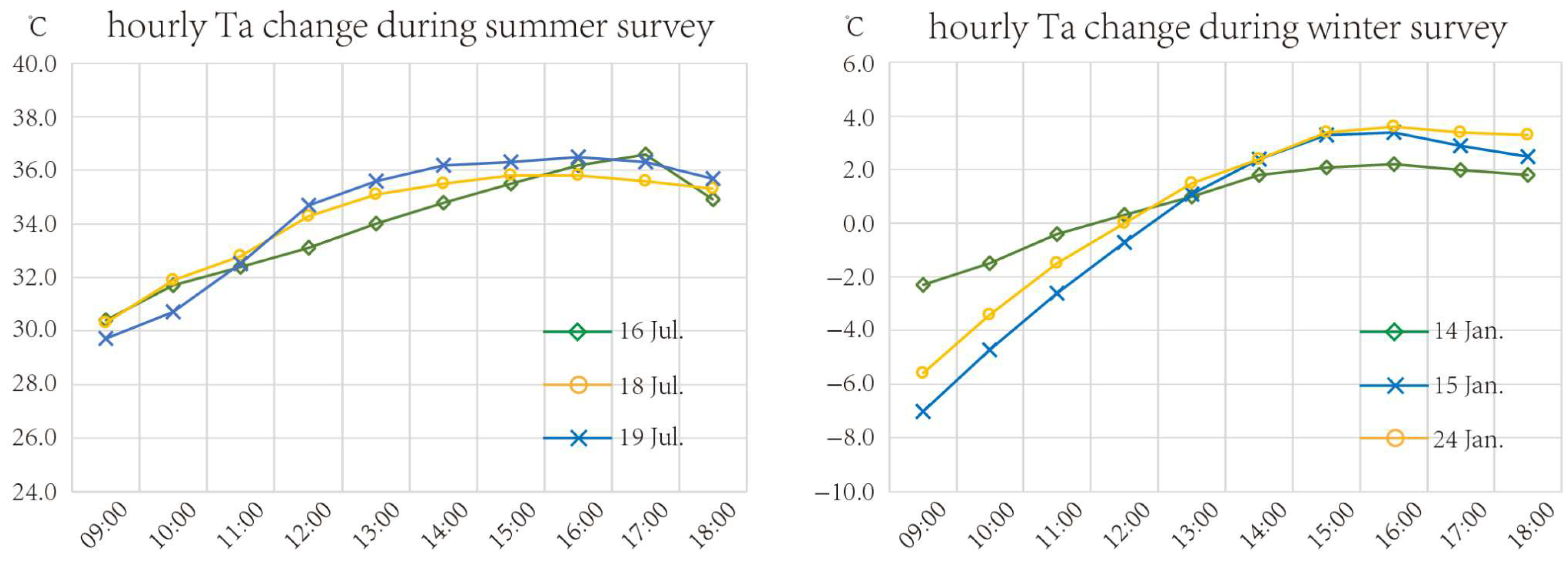

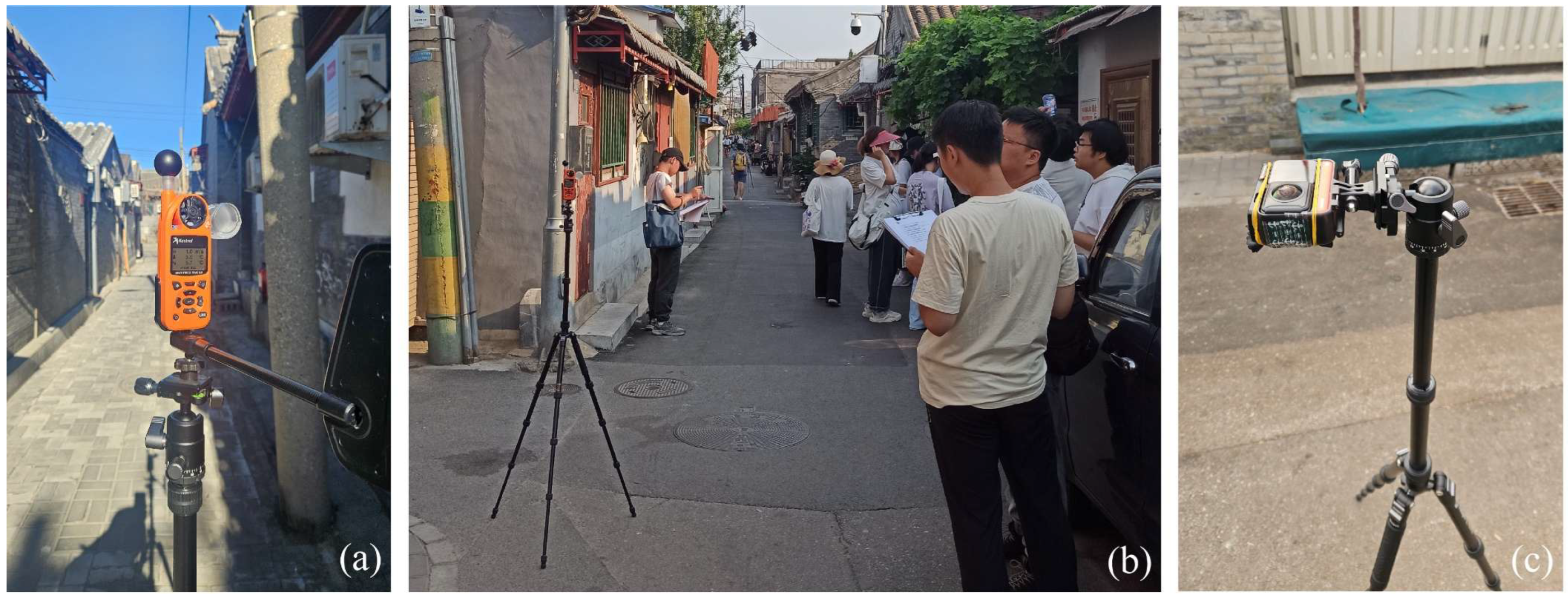
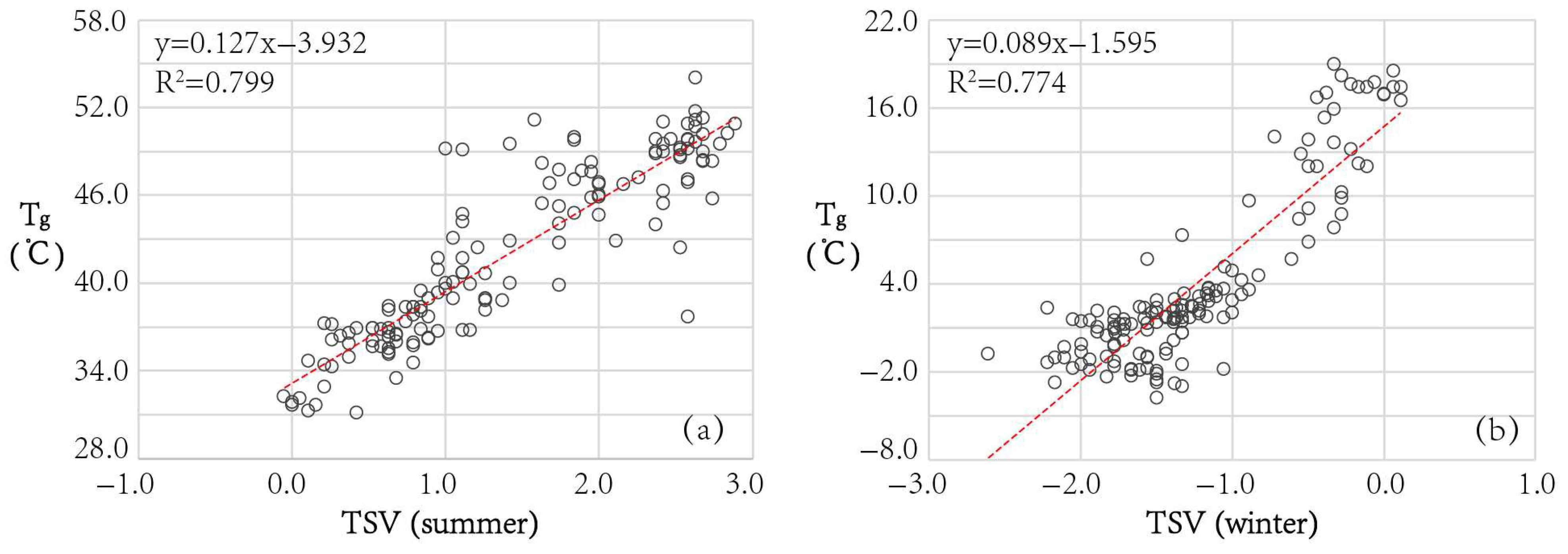
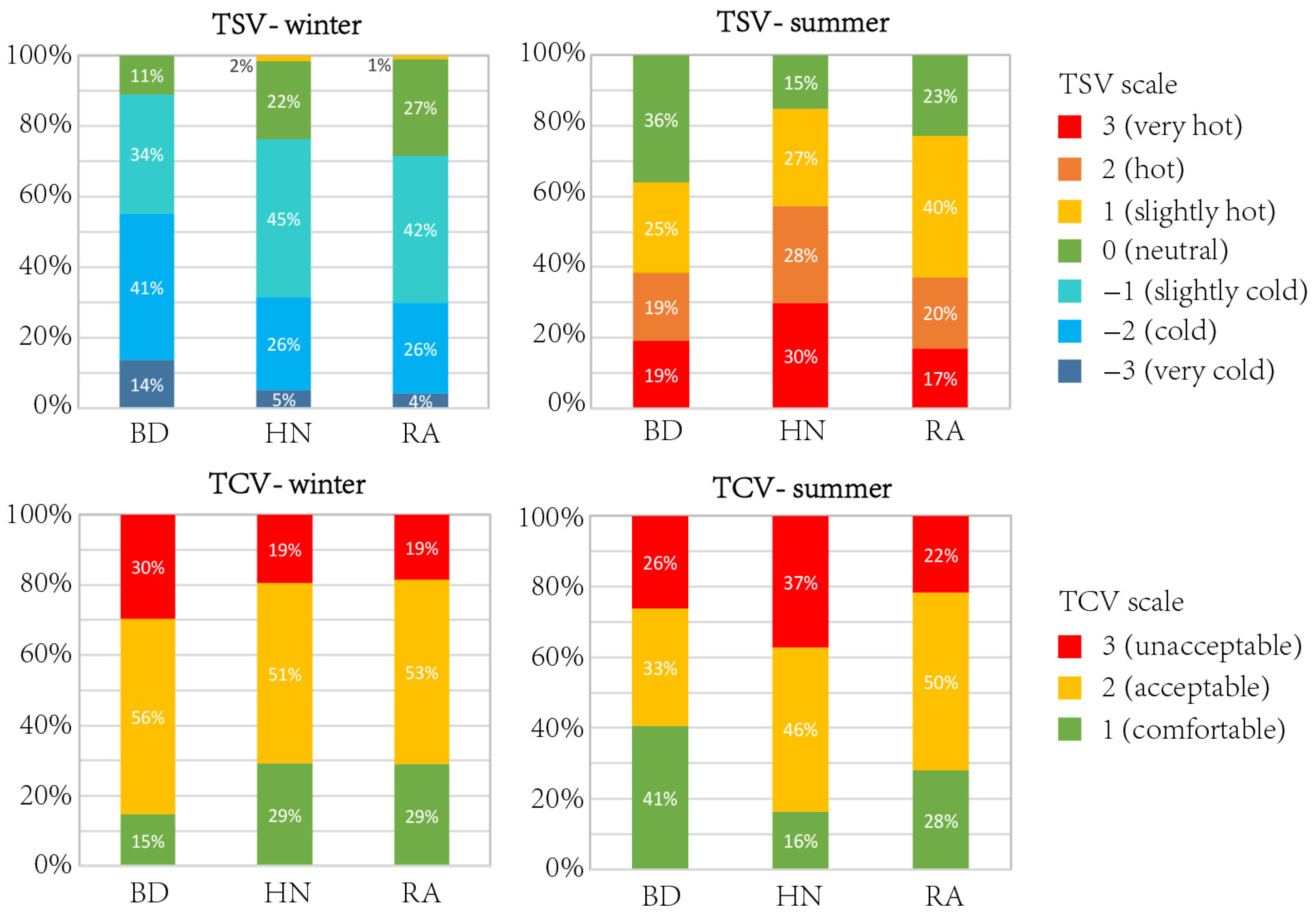



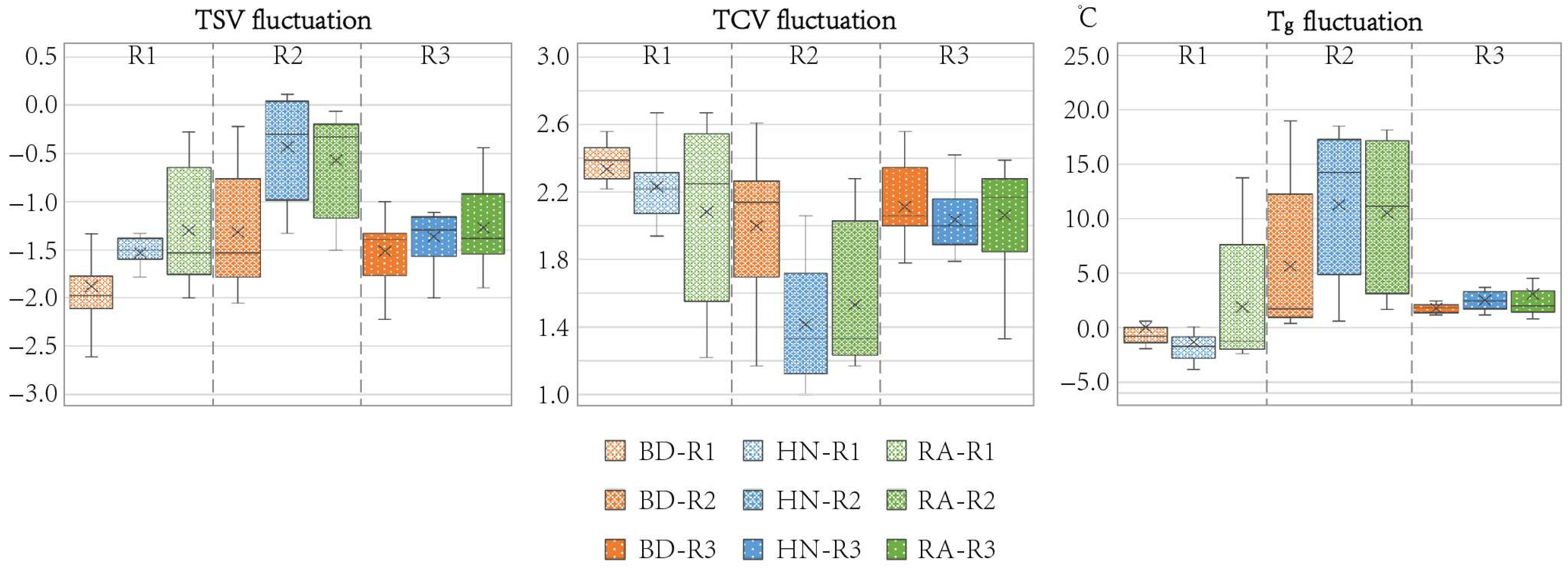

| Season | Date | Location |
|---|---|---|
| Summer | 16 July 2023 | BD |
| 18 July 2023 | TN | |
| 19 July 2023 | RA | |
| Winter | 14 January 2024 | BD |
| 15 January 2024 | RA | |
| 24 January 2024 | TN |
| Measured Parameter | Logger | Measurement Range | Accuracy | Measured Interval |
|---|---|---|---|---|
| Air temperature (°C) | Kestrel NK5400 Heat Stress Tracker | −29–70 °C | ±0.5 °C | 5 s |
| Relative humidity (%) | 0–100% | ±2% | 5 s | |
| Wind speed (m/s) | 0.6–40 m/s | ±3% | 5 s | |
| Globe temperature (°C) | −29–60 °C | ±1.4 °C | 5 s |
| Season | Summer | Winter | ||||
|---|---|---|---|---|---|---|
| BD | HN | RA | BD | HN | RA | |
| mTSV | 1.21 | 1.72 | 1.31 | −1.57 | −1.11 | −1.05 |
| mTCV | 1.86 | 2.21 | 1.94 | 2.15 | 1.90 | 1.89 |
| Location | Round | mTSV | mTCV | mTg (°C) |
|---|---|---|---|---|
| BD | R1 | 0.78 | 1.59 | 39.1 |
| R2 | 1.77 | 2.21 | 44.2 | |
| R3 | 1.09 | 1.77 | 40.2 | |
| HN | R1 | 1.33 | 2.04 | 41.7 |
| R2 | 2.31 | 2.48 | 47.0 | |
| R3 | 1.51 | 2.10 | 43.5 | |
| RA | R1 | 1.20 | 1.90 | 39.4 |
| R2 | 1.68 | 2.17 | 43.5 | |
| R3 | 1.05 | 1.76 | 39.4 |
| Location | Round | mTSV | mTCV | mTg (°C) |
|---|---|---|---|---|
| BD | R1 | −1.88 | 2.33 | 0.1 |
| R2 | −1.32 | 2.00 | 5.7 | |
| R3 | −1.51 | 2.11 | 1.8 | |
| HN | R1 | −1.53 | 2.23 | −1.3 |
| R2 | −0.43 | 1.42 | 11.3 | |
| R3 | −1.36 | 2.04 | 2.5 | |
| RA | R1 | −1.30 | 2.08 | 1.9 |
| R2 | −0.57 | 1.53 | 10.5 | |
| R3 | −1.27 | 2.06 | 3.1 |
| Season | Time | SVF | BCR | BH |
|---|---|---|---|---|
| Summer | R1 | 0.481 ** | 0.182 | −0.339 * |
| R2 | 0.530 ** | 0.212 | −0.259 | |
| R3 | 0.249 | 0.304 * | −0.260 | |
| All day | 0.554 ** | 0.301 * | −0.369 * | |
| Winter | R1 | 0.279 | 0.085 | −0.388 ** |
| R2 | 0.402 ** | 0.277 | −0.384 ** | |
| R3 | 0.181 | 0.011 | −0.120 | |
| All day | 0.434 ** | 0.212 | −0.454 ** |
| Summer | Winter | ||||||||
|---|---|---|---|---|---|---|---|---|---|
| Block | Time | SVF | BCR | BH | Block | Time | SVF | BCR | BH |
| BD | R1 | 0.203 | −0.158 | −0.249 | BD | R1 | 0.312 | −0.034 | −0.131 |
| R2 | 0.456 | −0.298 | −0.258 | R2 | 0.148 | −0.432 | −0.069 | ||
| R3 | −0.039 | 0.247 | −0.285 | R3 | 0.171 | 0.011 | 0.221 | ||
| All day | 0.291 | −0.109 | −0.333 | All day | 0.377 | −0.362 | −0.041 | ||
| HN | R1 | 0.267 | 0.554 * | 0.417 | HN | R1 | −0.148 | 0.619 * | 0.358 |
| R2 | 0.181 | 0.335 | −0.325 | R2 | 0.155 | −0.194 | −0.096 | ||
| R3 | 0.651 ** | 0.243 | −0.099 | R3 | −0.141 | 0.171 | −0.037 | ||
| All day | 0.569 * | 0.601 * | 0.004 | All day | 0.013 | 0.121 | 0.028 | ||
| RA | R1 | 0.662 ** | −0.210 | −0.381 | RA | R1 | −0.253 | 0.379 | 0.329 |
| R2 | 0.773 ** | −0.338 | −0.534 * | R2 | 0.495 * | −0.218 | −0.423 | ||
| R3 | 0.143 | −0.290 | −0.505 * | R3 | −0.02 | −0.218 | 0.009 | ||
| All day | 0.689 ** | −0.361 | −0.652 ** | All day | 0.090 | 0.019 | −0.016 |
| Block | Summer | Winter | ||||
|---|---|---|---|---|---|---|
| Round of Survey | mTSV of E–W Street | mTSV of N–S Street | Round of Survey | mTSV of E–W Street | mTSV of N–S Street | |
| BD | R1 * | 0.93 | 0.62 | R1 * | −1.69 | −1.94 |
| R2 | 1.64 | 1.68 | R2 * | −1.80 | −1.00 | |
| R3 * | 1.33 | 0.98 | R3 | −1.51 | −1.49 | |
| All-day * | 1.30 | 1.10 | All-day * | −1.67 | −1.48 | |
| HN | R1 * | 1.47 | 1.10 | R1 | −1.56 | −1.49 |
| R2 | 2.32 | 2.29 | R2 * | −0.59 | −0.16 | |
| R3 * | 1.81 | 1.02 | R3 | −1.40 | −1.30 | |
| All-day * | 1.87 | 1.47 | All-day * | −1.18 | −0.98 | |
| RA | R1 * | 1.26 | 1.12 | R1 * | −1.44 | −1.12 |
| R2 | 1.63 | 1.66 | R2 * | −0.71 | −0.24 | |
| R3 * | 1.36 | 0.91 | R3 * | −1.11 | −1.31 | |
| All-day * | 1.42 | 1.24 | All-day * | −1.09 | −0.89 |
Disclaimer/Publisher’s Note: The statements, opinions and data contained in all publications are solely those of the individual author(s) and contributor(s) and not of MDPI and/or the editor(s). MDPI and/or the editor(s) disclaim responsibility for any injury to people or property resulting from any ideas, methods, instructions or products referred to in the content. |
© 2025 by the authors. Licensee MDPI, Basel, Switzerland. This article is an open access article distributed under the terms and conditions of the Creative Commons Attribution (CC BY) license (https://creativecommons.org/licenses/by/4.0/).
Share and Cite
Zhao, T.; Ma, T. Temporal-Spatial Thermal Comfort Across Urban Blocks with Distinct Morphologies in a Hot Summer and Cold Winter Climate: On-Site Investigations in Beijing. Atmosphere 2025, 16, 855. https://doi.org/10.3390/atmos16070855
Zhao T, Ma T. Temporal-Spatial Thermal Comfort Across Urban Blocks with Distinct Morphologies in a Hot Summer and Cold Winter Climate: On-Site Investigations in Beijing. Atmosphere. 2025; 16(7):855. https://doi.org/10.3390/atmos16070855
Chicago/Turabian StyleZhao, Tengfei, and Tong Ma. 2025. "Temporal-Spatial Thermal Comfort Across Urban Blocks with Distinct Morphologies in a Hot Summer and Cold Winter Climate: On-Site Investigations in Beijing" Atmosphere 16, no. 7: 855. https://doi.org/10.3390/atmos16070855
APA StyleZhao, T., & Ma, T. (2025). Temporal-Spatial Thermal Comfort Across Urban Blocks with Distinct Morphologies in a Hot Summer and Cold Winter Climate: On-Site Investigations in Beijing. Atmosphere, 16(7), 855. https://doi.org/10.3390/atmos16070855





